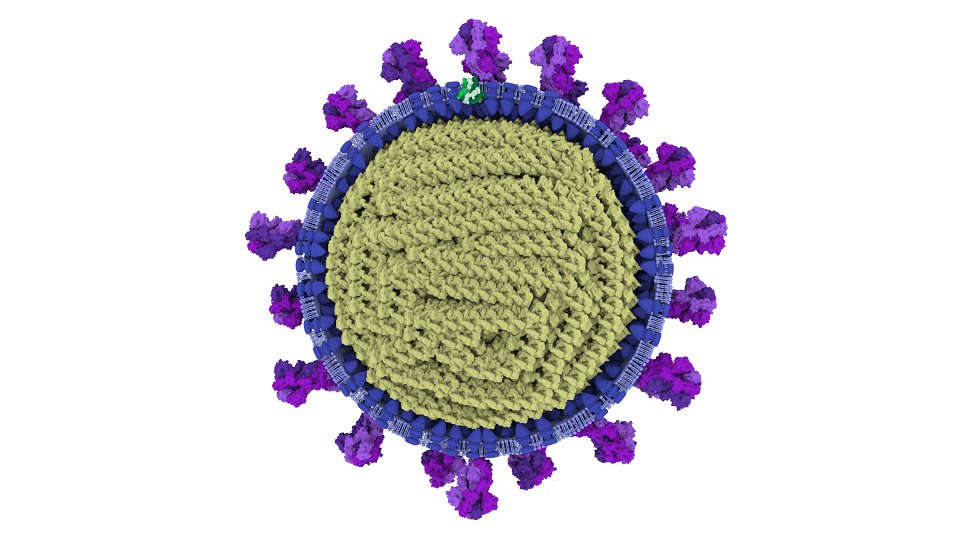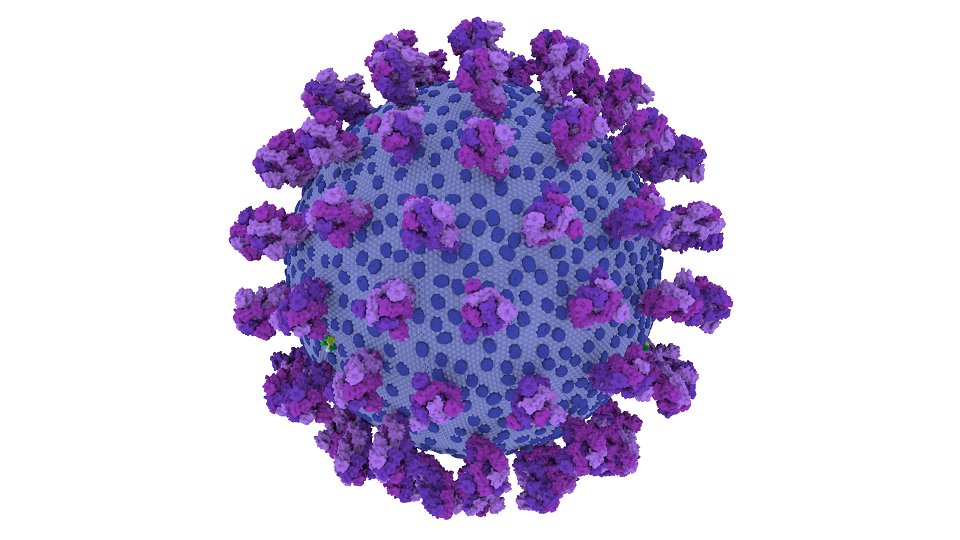
In a new paper led by @annasimsbiol, we find that influenza infections divide your throat into tiny territories, and ask:
why don’t these viruses want to be friends?
Paper doi.org/10.1371/journa…
Commentary doi.org/10.1371/journa…
A 🧵
why don’t these viruses want to be friends?
Paper doi.org/10.1371/journa…
Commentary doi.org/10.1371/journa…
A 🧵

Some background: If two viruses get into the same cell, they can genes exchange (basically they can breed). This is really important for viral evolution. A dramatic example is when different strains of influenza A virus (IAVs) use coinfection to generate pandemic strains 

Many viruses actively push back against coinfection, changing an infected cell until it becomes resistant to infection by related viruses. This effect is known as ‘superinfection exclusion’ (SIE) 

Why might SIE be important?
In the lab it normally isn’t, as we set up experiments where cells are simultaneously
In a natural infection though – breath in, and the chances of two viruses entering your airway, finding the same cell, and entering it at the same moment are… slim
In the lab it normally isn’t, as we set up experiments where cells are simultaneously
In a natural infection though – breath in, and the chances of two viruses entering your airway, finding the same cell, and entering it at the same moment are… slim
Presumably for influenza viruses (and many others), unrelated viruses first establish separate infections inside a host, then encounter each other when they spread through tissue, causing disease and onwards transmission.
How might SIE control these spreading infections?
How might SIE control these spreading infections?
Following the spread of an infection inside a living animal is not easy, so we started with a model: cell cultures, and modified IAVs that differed only in the colour of a fluorescent tag
We saw that for IAV SIE starts rapidly and early after a short window for coinfection
We saw that for IAV SIE starts rapidly and early after a short window for coinfection

To observe spread we used every virologist’s favourite assay: the #PlaqueAssay! 🥳
When two growing plaques collide, different spreading viruses meet. We see that coinfection can only occur in a thin boundary of recently-infected cells. Beyond that point, SIE is fully effective
When two growing plaques collide, different spreading viruses meet. We see that coinfection can only occur in a thin boundary of recently-infected cells. Beyond that point, SIE is fully effective

What about interactions within a single, spreading, infected region?
To look at this we needed plaques that were a mixture of two viruses. As the mixed plaques spread, would coinfection be maintained, or would the plaques split into descendants of single viruses?
Any guesses?
To look at this we needed plaques that were a mixture of two viruses. As the mixed plaques spread, would coinfection be maintained, or would the plaques split into descendants of single viruses?
Any guesses?

Setting up mixed plaques required a bit of creativity
We coinfected cells simultaneously, dissociated them with trypsin, diluted them, then reseeded them onto new cells so that each coinfected cell was now a plaque forming unit
And we found…
We coinfected cells simultaneously, dissociated them with trypsin, diluted them, then reseeded them onto new cells so that each coinfected cell was now a plaque forming unit
And we found…

… that they stayed well-mixed as they spread.
This wasn’t the result we expected, but it makes sense – each new cell in a growing plaque can receive plenty of both colours of virus before SIE kicks in
This wasn’t the result we expected, but it makes sense – each new cell in a growing plaque can receive plenty of both colours of virus before SIE kicks in

This is all very well and good, but is it just a cell culture artefact?
Plaque assays are not lungs, after all.
So we infected mice with both viruses…
Plaque assays are not lungs, after all.
So we infected mice with both viruses…

… and found that once lesions had grown there were clear boundaries between the two colours inside the same anatomical compartments.
So it seems SIE can impose its patterns inside a host, as well as in a dish
So it seems SIE can impose its patterns inside a host, as well as in a dish

What does this mean? 🤔
•Within a host, flu infections divide into a landscape of tiny territories
•Viruses can exchange genes within a territory, but ‘breeding’ between territories is unusual
•This is not a specific mechanism, and could also apply for many other viruses
•Within a host, flu infections divide into a landscape of tiny territories
•Viruses can exchange genes within a territory, but ‘breeding’ between territories is unusual
•This is not a specific mechanism, and could also apply for many other viruses

Bonus things not in the paper but worth mentioning!
This project was triggered by two ideas:
(1) listening to #TWiV while lagging the loft, I heard about this cool paper and thought ‘I wonder if flu does this?’ (Spoiler: actually it probably doesn't)
pubmed.ncbi.nlm.nih.gov/30318351/
This project was triggered by two ideas:
(1) listening to #TWiV while lagging the loft, I heard about this cool paper and thought ‘I wonder if flu does this?’ (Spoiler: actually it probably doesn't)
pubmed.ncbi.nlm.nih.gov/30318351/
(2) after a seminar in which I made some careless comment about cells in a host obviously getting coinfected all the time, @Digs66768072 asked the best and most annoying question in science:
‘… but why do you think that’s true?’
(it was not and I was wrong)
‘… but why do you think that’s true?’
(it was not and I was wrong)
Also worth mentioning was how great the submission process was
(I know! Let’s share examples of people doing this well)
(I know! Let’s share examples of people doing this well)
This started with @npariente going out of her way at a conference to give @annasimsbiol advice on her first big project, including ‘think of a journal you could submit to, then aim one higher’
(then following up by e-mail to clarify that yes, she did actually mean @PLOSBiology)
(then following up by e-mail to clarify that yes, she did actually mean @PLOSBiology)
It continued with exceptionally clear editorial requests during revision from @Paula_Jauregui_ and @MehleLab @PLOSBiology , who were direct and to the point about what they wanted if the paper was going to be accepted
I can’t begin to tell you how helpful (and uncommon) that is
I can’t begin to tell you how helpful (and uncommon) that is
Also thanks to the reviewers who made some suggestions that (much as it pains us to admit it) genuinely improved the paper
Some of these were from @anice_lowen. We know this because she signed her review (‘something of a power move there’ – Anna). Thanks Anice!
Some of these were from @anice_lowen. We know this because she signed her review (‘something of a power move there’ – Anna). Thanks Anice!
Thanks also to @anice_lowen and @LucasFerreri1 for their thought-provoking commentary, which does a great job of putting this work in a wider context
We found this really helpful to read ourselves when thinking about where to go next with this:
journals.plos.org/plosbiology/ar…
We found this really helpful to read ourselves when thinking about where to go next with this:
journals.plos.org/plosbiology/ar…
Finally, thanks to everyone who worked on this: #LauraBurgessTornaletti, @snjasim, @chiara_pirillo, #RyanDevlin, @jack__stat, @Onlycloney, @jowojtus, @DrLizSloan, @lukethorley96, #ChrisBoutell and #EdRoberts, to the rest of team @CVRHutchinson…
… and most of all thanks to lead author @annasimsbiol,
all of whose infections
are super
all of whose infections
are super
https://twitter.com/CVRinfo/status/1623985941198020608?s=20&t=jCEiz3knfsGt6i31fxIbSw
Follow up:
Thanks very much to @HelenPuttick for reporting on this for @thetimes [article behind paywall]!
Thanks very much to @HelenPuttick for reporting on this for @thetimes [article behind paywall]!
https://twitter.com/HelenPuttick/status/1623967686249046019?s=20&t=rbV8zU_VOiiuUmMoPsHZ-A
• • •
Missing some Tweet in this thread? You can try to
force a refresh















